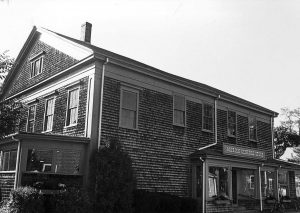In 1998, the Sippican Historical Society commissioned an architectural survey of Marion’s historic homes and buildings. The survey was funded one-half by the Sippican Historical Society and one-half by the Massachusetts Historical Commission. Because of the limits of funding, not all of the historic buildings were surveyed, but over 100 were catalogued and photographed. The results of the survey are in digital form on the Massachusetts Historical Commission’s website and in four binders in the Sippican Historical Society’s office (and at the Marion Town Clerk’s office). Marion (Old Rochester) is one of the oldest towns in the United States, and the Sippican Historical Society maintains an extensive collection of documentation on its historic buildings. The Sippican Historical Society will preview one building a week so that the residents of Marion can understand more about its unique historical architecture. This installment features 140 Front Street.
The Congregational Meetinghouse (now the Marion General Store) at 140 Front Street was built between 1794 and 1799, during the Federal period. In the 1840s, the Greek Revival style was employed to update this building, which marks the southern entrance to the town center’s small commercial district. The Congregational Meetinghouse, more than any other building, symbolized Wharf Village as an important new focus for the spiritual, commercial, and social life in Marion. It also represented the first step toward independence from its mother town of Rochester. For the first time since the early 1700s, the town folk did not have to travel to Rochester center to partake in religious services.
